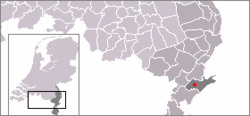Sint Odiliënberg
| Sint Odiliënberg | |
|---|---|
.jpg) | |
 | |
| Coordinates: 51°08′35″N 6°00′10″E / 51.14306°N 6.00278°ECoordinates: 51°08′35″N 6°00′10″E / 51.14306°N 6.00278°E | |
| Country | Netherlands |
| Province | Limburg |
| Municipality | Roerdalen |
| Population (1 January 2006) | 3,570 |
| Dialling code | 0475 |
| Major roads | N293 |
Sint Odiliënberg is a small village in central Limburg, in the Netherlands, east of the river Maas in the Roer valley. It is one of the six villages in the municipality of Roerdalen.
Standing on a hill is a Romanesque basilica with two towers dating from the eleventh century. Next to the basilica is a 10th-century chapel, originally the parish church.
Until 1991, Sint Odiliënberg was a separate municipality. Since then it has been part of Ambt Montfort which in January 2007 formed a new municipality together with Roerdalen under the name of Roerdalen.
History
Sint Odiliënberg is a few kilometres south of Roermond, lying along the small Roer river. Romans settled here very early. In 706 missionary monks from Ireland, Saints Wiro, Plechelmus, and Otgerus, built a monastery there, which was important in the Christianisation of the Netherlands. In the time of the Viking invasions the Utrecht clergy found shelter here. At first it was a secular collegiate chapter, which later moved to Roermond in the 14th century. A community of the Canons Regular of the Holy Sepulchre settled on the hill during that period.
After the Eighty Years' War, this area came under Spanish rule; it was ceded to the Dutch Republic in 1715. Until the French municipal reorganisation, St. Odiliënberg belonged to the administrative division known as Ambt Montfort, but it became a separate commune/municipality c. 1810, until it again merged with Ambt Montfort and later with Roerdalen.
Gallery
 Sint Odiliënberg, basilica
Sint Odiliënberg, basilica- Sint Odiliënberg, windmill: molen van Verbeek
Notable residents
- Connie Palmen, writer, born in St. Odiliënberg
- Geert Chatrou, professional whistler, born in St. Odiliënberg
External links
- J. Kuyper, Gemeente Atlas van Nederland, 1865-1870, "Sint Odiliënberg". Map of the former municipality, around 1868.
